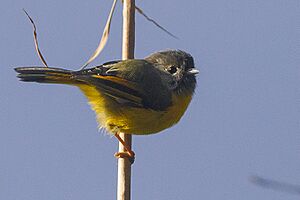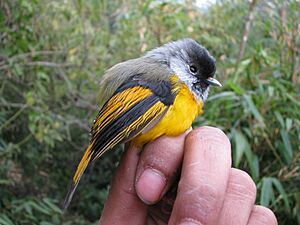Golden-breasted fulvetta facts for kids
Quick facts for kids Golden-breasted "fulvetta" |
|
|---|---|
 |
|
| Pangolakha WLS in East Sikkim, India. | |
| Conservation status | |
| Scientific classification | |
| Genus: |
Lioparus
|
| Species: |
chrysotis
|
| Synonyms | |
|
|
The golden-breasted fulvetta (Lioparus chrysotis) is a small, colorful songbird. You can find this bird in parts of Asia, including Bhutan, China, India, Myanmar, Nepal, and Vietnam. It likes to live in cool, wet forests, especially in mountains.
About Its Name
When the golden-breasted fulvetta was first described in 1845, it was given the scientific name Proparus chrysotis. This was done by Edward Blyth, who used notes from a naturalist named Brian Houghton Hodgson.
Later, in 1889, a scientist named Eugene William Oates decided this bird was special enough to have its own group, or genus, called Lioparus. He noticed it had a wider bill and smaller back claws compared to other birds in the Proparus group. So, the golden-breasted fulvetta became the only member of the Lioparus genus.
There are six different types, or subspecies, of the golden-breasted fulvetta. They are mostly named after where they live:
- L. c. chrysotis: This is the original type. It lives from central Nepal to northeastern India and southern China. It has a grey chin and throat.
- L. c. albilineatus: Found in northeastern India. This type is said to have brighter feathers.
- L. c. forresti: Lives in northeastern Myanmar and northwestern Yunnan in China. It has white spots on its head that turn yellowish. It's named after George Forrest, who collected the first sample.
- L. c. swinhoii: Found in a large area of China, from Gansu to Guangdong.
- L. c. amoenus: Lives in southeastern Yunnan in China and northwestern Vietnam.
- L. c. robsoni: Found in central Vietnam. This one has a yellow throat and chin.
What It Looks Like

The golden-breasted fulvetta is a tiny bird, usually about 10 to 11.5 centimeters (4 to 4.5 inches) long. It weighs between 5 and 10 grams (about 0.2 to 0.35 ounces), which is very light!
Its head and the top of its head can be black or grey. Its black wings have bright orange-yellow stripes. The tips of some wing feathers are white. Its brown tail has orange-yellow edges near the base. The underside of the bird is mostly yellow. The color of its throat can be grey or yellowish, depending on where it lives. Some birds have a white stripe on the top of their head, but this can also vary. Male and female golden-breasted fulvettas look very similar.
Where It Lives and How It Behaves
The golden-breasted fulvetta lives across a wide area, from central Nepal through Bhutan, northern India, and Myanmar, all the way to western China and northern Vietnam.
These birds are what we call "altitudinal migrants." This means they move up and down mountains depending on the season. They breed (have their babies) in higher places, usually between 2,000 and 2,800 meters (about 6,500 to 9,200 feet) high. In winter, they move down to lower hills, sometimes as low as 1,300 meters (about 4,300 feet).
Golden-breasted fulvettas like to live in forests with broad-leaved evergreen trees and bamboo. They search for insects close to the ground. In winter, they often gather in groups of up to 30 birds. They also sometimes join other types of birds to look for food together.
Conservation Status
The International Union for Conservation of Nature (IUCN) lists the golden-breasted fulvetta as a species of "least concern." This means that even though its population might be getting smaller, it's not decreasing very quickly. Also, the bird lives in a very large area, which helps protect it.
However, in some places, people have been collecting these birds, either for food or to keep as pets. This puts some pressure on their populations.


